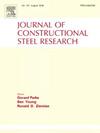三种断裂模型在模拟奥氏体不锈钢螺栓搭接剪切连接中的比较研究
IF 4
2区 工程技术
Q1 CONSTRUCTION & BUILDING TECHNOLOGY
引用次数: 0
摘要
本文深入研究了孔洞扩展模型、Lee-Wierzbicki模型和Bai-Wierzbicki模型三种具有代表性的断裂模型在模拟不锈钢螺栓搭接剪切连接断裂行为中的性能。最终目标是确定合适的裂缝模型,以最小的校准要求提供满意的模拟结果。为了校准断裂模型,进行了五种不同类型的材料试验,所有试样均取自同一块304级奥氏体不锈钢板。随后,采用与材料试验相同的钢板制作了5个连接试验,以检验不同模型在模拟典型连接破坏模式(即网段断裂、撕裂和块体剪切)方面的性能。结果表明,与其他两种模型相比,具有2个单独模型参数且仅与应力三轴相关的Lee-Wierzbicki模型的模拟结果最为准确。孔洞扩展模型只有一个参数,通过拉伸主导材料试验校准,不能模拟剪切开裂的起裂,导致模拟结果不保守。由于连接处的临界应力状态接近于平面应力,具有4个参数且均与应力三轴性和Lode角相关的Bai-Wierzbicki模型的精度不如Lee-Wierzbicki模型。研究结果表明,对于某些工程问题,更复杂的裂缝模型和更多的模型参数不一定能得到更准确的模拟结果。进一步建议,应根据所研究问题的普遍应力状态选择断裂模型和校准程序(包括用于校准的材料试样)。本文章由计算机程序翻译,如有差异,请以英文原文为准。
A comparative study of three fracture models in simulating austenitic stainless steel bolted lap shear connections
This paper thoroughly investigates the performances of three representative fracture models, namely the void growth model, the Lee-Wierzbicki model and the Bai-Wierzbicki model, in simulating the fracture behaviour of stainless steel bolted lap shear connections. The ultimate goal is to determine the appropriate fracture model that can provide satisfactory simulation results with the minimum calibration requirement. To calibrate the fracture models, five different types of material test were performed, with all test specimens extracted from a single austenitic stainless steel plate of Grade 304. Thereafter, five connection tests, fabricated from the same steel plate as the material tests, were performed to examine the performances of different models in simulating typical connection failure modes (i.e. net section fracture, tearout and block shear). It was concluded that the Lee-Wierzbicki model, with 2 individual model parameters and only stress triaxiality-dependency, generated the most accurate simulation results compared with the other two models. The void growth model, with only one parameter calibrated by a tensile-dominant material test, failed to simulate the initiation of shear cracking and led to unconservative simulation results. Since the critical stress states in the connections were close to plane stress, the Bai-Wierzbicki model, with four parameters and both stress triaxiality- and Lode angle-dependencies, did not show improved accuracy than the Lee-Wierzbicki model. The results of the study indicate that a more sophisticated fracture model with greater number of model parameters may not necessarily lead to more accurate simulation results for certain engineering problems. It is further recommended that the selection of fracture model and calibration procedure (including material test specimens for calibration) should be based on the prevalent stress states in the investigated problems.
求助全文
通过发布文献求助,成功后即可免费获取论文全文。
去求助
来源期刊

Journal of Constructional Steel Research
工程技术-工程:土木
CiteScore
7.90
自引率
19.50%
发文量
550
审稿时长
46 days
期刊介绍:
The Journal of Constructional Steel Research provides an international forum for the presentation and discussion of the latest developments in structural steel research and their applications. It is aimed not only at researchers but also at those likely to be most affected by research results, i.e. designers and fabricators. Original papers of a high standard dealing with all aspects of steel research including theoretical and experimental research on elements, assemblages, connection and material properties are considered for publication.
 求助内容:
求助内容: 应助结果提醒方式:
应助结果提醒方式:


